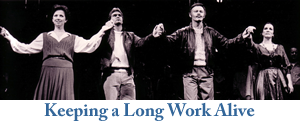Composer’s Thoughts
In the 1980s and ’90s I began to differentiate between influence and resonance. ‘Influence’ in the sense of direct musical influences and quotes from a specific composer. For example, I directly quote a moment from the third movement of Schoenberg’s Five Pieces for Orchestra in Mestiere. As opposed to the use of ‘resonance’ in my 1983 Piano Concerto in which I acknowledge a lifelong passion for the music of George Gershwin and Aaron Copland and incorporate their sounds into the texture of my work without imitating their music. I developed new structures, as in Piano Sonata (1986; revised 1987), which adopts the modular arrangement of a triptych lithograph by Jasper Johns. I developed new textures, as in Traverso, for flute and piano (1987), where I blend Japanese transparency with the heroic and open musical landscape suggested by American harmonies of the 1930s and ’40s. The title of Resisting Stillness, for two guitars (1996), suggests a way of listening to the work and reflects my creative struggle at the time—a personal pulling up from silence—as well as my interest in the power of pure sound wedded to lyrical line.
My lyrical impulses became more pronounced in the ‘80s after working with Henry Butler’s libretto and the characters in the 1985 chamber opera, Tight-Rope. I increasingly turned to text setting as a vehicle for emotional and dramatic structure. In the song-cycle, The Gift of Life, for soprano and piano (1990-1993), I chose two poems and a narrative text by Emily Dickinson, Denise Levertov and Thornton Wilder to speak of birth, life, memory, loss, death, and, finally, love. In other songs I set the words of Allen Ginsberg (“Guru”), Sheldon Harnick (“Chez Vous”), Muriel Rukeyser (“Recovering”) and Carl Sandburg (“Baby Song of the Four Winds” and “Prayers of Steel”). Modern Love Songs (1997-2002), a cycle that sits somewhere between cabaret/standard tunes and art songs, reflects a passion for the American Songbook shared with the writer/lyricist, William Zinsser. And Sailors & Dreamers, for voice and chamber ensemble or piano (2007-2020), written with the poet/playwright/painter/director, Shirley Kaplan, pays tribute to the tides and the currents that carry us forward to the new and the unexpected.




